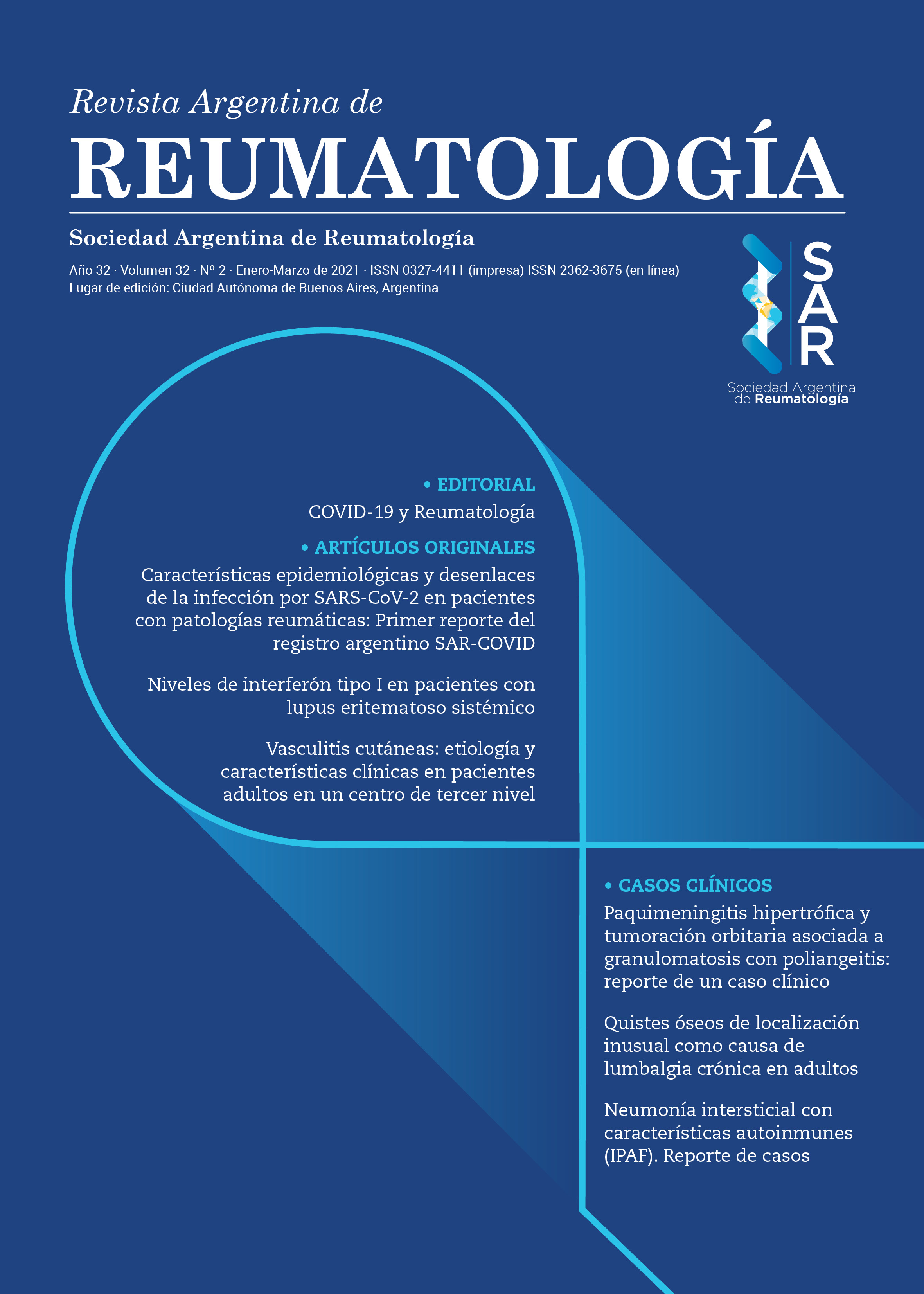Tolerance, survival and adherence to treatment with methotrexate in patients with rheumatoid arthritis
Abstract
Background: Methotrexate (MTX) is the most frequently used medication in patients with Rheumatoid Arthritis (RA). However, several authors have questioned its success due to the presence of adverse events and the lack of adherence. Objectives: to determine cumulative survival of MTX, frequency and type of adverse events and causes of discontinuation in patients with RA. Methods: consecutive patients 18 years and older with a diagnosis of RA (ACR/EULAR 2010 criteria), who had begun treatment with MTX during their disease were included. Sociodemographic, clinical and therapeutic data were collected. Date of initiation and suspension of MTX, route of administration, concomitant treatments, consumption of coffee and tobacco, presence of adverse events (AE) were all consigned. Adherence was evaluated using the Compliance Questionnaire Rheumatology questionnaire 5-item summary version (CQR5). Statistical analysis: descriptive statistics. Chi2 test or Fisher’s exact test; Survival of treatment by Kaplan-Meier and log Rank. Multiple logistic regression. A p value <0.05 was considered significant.References
I. Maldonado Cocco J, Citera G.Reumatología, Azzurras. Buenos Aires; 2013.
II. Smolen JS, Landewé R, Bijlsma J, Burmester G, Chatzidionysiou K, Dougados M, et al. EULAR recommendations for the management of rheumatoid arthritis with synthetic and biological disease-modifying antirheumatic drugs: 2016 update. Ann. Rheum. Dis. 2017;76(6):960–977.
III. Curtis JR, Bykerk VP, Aassi M, Schiff M. Adherence and persistence with methotrexate in rheumatoid arthritis: A systematic review. J. Rheumatol. 2016;43(11):1997–2009.
IV. Ideguchi H, Ohno S, Ishigatsubo Y. Risk factors associated with the cumulative survival of low-dose methotrexate in 273 Japanese patients with rheumatoid arthritis. J. Clin. Rheumatol. 2007;13(2):73–78.
V. Hoekstra M, Van De Laar MAFJ, Bernelot Moens HJ, Kruijsen MWM, Haagsma CJ. Longterm Observational Study of Methotrexate Use in a Dutch Cohort of 1022 Patients with Rheumatoid Arthritis. J. Rheumatol. 2003;30(11):2325–2329.
VI. Scully J, Anderson J, Cannon GW. Long-term methotrexate therapy for rheumatoid arthritis. Semin. Arthritis Rheum. 1991;20(5):317–331.
VII. Nikiphorou E, Negoescu A, Fitzpatrick JD, Goudie CT, Badcock A, Ösẗor AJK, et al. Indispensable or intolerable? Methotrexate in patients with rheumatoid and psoriatic arthritis: A retrospective review of discontinuation rates from a large UK cohort. Clin. Rheumatol. 2014;33(5):609–614.
VIII. Wang W, Zhou H, Liu L. Side effects of methotrexate therapy for rheumatoid arthritis: A systematic review. Eur. J. Med. Chem. 2018;158(1):502–516.
IX. De Cuyper E, De Gucht V, Maes S, Van Camp Y, De Clerck LS. Determinants of methotrexate adherence in rheumatoid arthritis patients. Clin. Rheumatol. 2016;35(5):1335–1339.
X. Harley CR, Frytak JR, Tandon N. Treatment compliance and dosage administration among rheumatoid arthritis patients receiving infliximab, etanercept, or methotrexate. Am. J. Manag. Care. 2003;9(6 Suppl):S136-43.
XI. Malaviya AN. Methotrexate intolerance in the treatment of rheumatoid arthritis (RA): effect of adding caffeine to the management regimen. Clin. Rheumatol. 2017;36(2):279–285.
XII. Aletaha D, Neogi T, Silman AJ, Funovits J, Felson DT, Bingham CO, et al. 2010 Rheumatoid arthritis classification criteria: An American College of Rheumatology/European League Against Rheumatism collaborative initiative. Arthritis Rheum. 2010;62(9):2569–2581.
XIII. Hoekstra M, van Ede AE, Haagsma CJ, van de Laar MAFJ, Huizinga TWJ, Kruijsen MWM, et al. Factors associated with toxicity, final dose, and efficacy of methotrexate in patients with rheumatoid arthritis. Ann. Rheum. Dis. 2003;62(5):423–6.
XIV. Hughes LD, Done J, Young A. A 5 item version of the Compliance Questionnaire for Rheumatology (CQR5) successfully identifies low adherence to DMARDs. BMC Musculoskelet. Disord. 2013;14(1):1.
XV. de Klerk E, van der Heijde D, Landewé R, van der Tempel H, van der Linden S. The compliance-questionnaire-rheumatology compared with electronic medication event monitoring: a validation study. J. Rheumatol. 2003;30(11):2469–75.
XVI. Arturi P, Schneeberger EE, Sommerfleck F, Buschiazzo E, Ledesma C, Maldonado Cocco JA, et al. Adherence to treatment in patients with ankylosing spondylitis. Clin. Rheumatol. 2013;32(7):1007–1015.
XVII. Londono J, Santos AM, Santos PI, Cubidez MF, Guzman C, Valle-Oñate R. Therapeutic efficacy and safety of methotrexate + leflunomide in Colombian patients with active rheumatoid arthritis refractory to conventional treatment. Rev. Bras. Reumatol. 2012;52(6):837–845.
XVIII. Sánchez G, Castro JS, Snih S Al, Blanco LP, Esteva MH, MacGregor EG, et al. Durability of treatment with methotrexate in Venezuelan patients with rheumatoid arthritis. Rheumatol. Int. 2007;27(6):531–536.
XIX. Kromann CB, Lage-Hansen PR, Koefoed M, Jemec GBE. Does switching from oral to subcutaneous administration of methotrexate influence on patient reported gastro-intestinal adverse effects? J. Dermatolog. Treat. 2015;26(2):188–190.
XX. Sotoudehmanesh R, Anvari B, Akhlaghi M, Shahraeeni S, Kolahdoozan S. Methotrexate hepatotoxicity in patients with rheumatoid arthritis. Middle East J. Dig. Dis. 2010;2(2):104–9.
XXI. Reed G, Greenberg JD, Kremer JM, Strand V, Beukelman T, Curtis JR, et al. Elevated liver enzyme tests among patients with rheumatoid arthritis or psoriatic arthritis treated with methotrexate and/or leflunomide. Ann. Rheum. Dis. 2009;69(1):43–47.
XXII. Shea B, Swinden M, Tanjong Ghogomu E, Ortiz Z, Katchamart W, Rader T, et al. - Folic acid and folinic acid for reducing side effects in patients receiving. Cochrane Database Syst Rev. 2013;31(6).
XXIII. . Kinder AJ, Hassell AB, Brand J, Brownfield A, Grove M, Shadforth MF. The treatment of inflammatory arthritis with methotrexate in clinical practice : treatment duration and incidence of adverse drug reactions. 2005;44(1):61–66.
XXIV. Nesher G, Mates M, Zevin S. Effect of caffeine consumption on efficacy of methotrexate in rheumatoid arthritis. Arthritis Rheum. 2003;48(2):571–572.
XXV. Yazici Y, Sokka T, Kautiainen H, Swearingen C, Kulman I, Pincus T. Long term safety of methotrexate in routine clinical care: Discontinuation is unusual and rarely the result of laboratory abnormalities. Ann. Rheum. Dis. 2005;64(2):207–211.
XXVI. Ugarte-Gil MF, Silvestre AMR, Pons-Estel BA. Access to an optimal treatment. Current situation. Clin. Rheumatol. 2015;34(1):59–66.
XXVII. Waimann CA, Marengo MF, De Achaval S, Cox VL, Garcia-Gonzalez A, Reveille JD, et al. Electronic monitoring of oral therapies in ethnically diverse and economically disadvantaged patients with rheumatoid arthritis: Consequences of low adherence. Arthritis Rheum. 2013;65(6):1421–1429.
Copyright (c) 2019 Argentine Journal of Rheumatology

This work is licensed under a Creative Commons Attribution-NonCommercial-NoDerivatives 4.0 International License.










